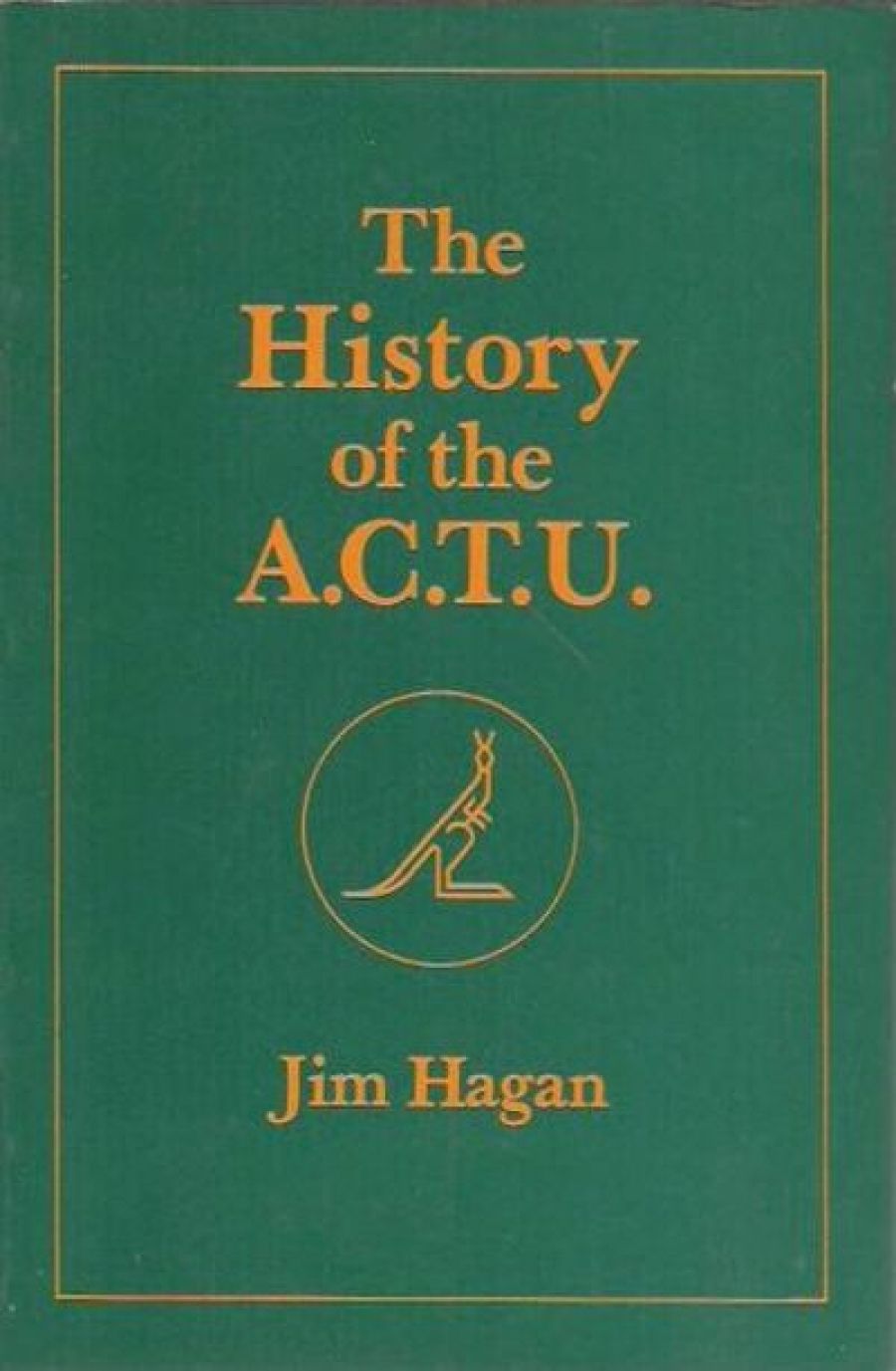
- Free Article: No
- Contents Category: Australian History
- Review Article: Yes
- Article Title: Settling for wages
- Online Only: No
- Custom Highlight Text:
Australia’s need for a definitive history about its national trade union centre has been handsomely filled by Jim Hagan. His exhaustively detailed study must become the base for future researchers who will seek to assess what happened in our times.
- Book 1 Title: The History of the ACTU
- Book 1 Biblio: Longman Cheshire, 476 p., $29.95, $15.95 pb
Realisation of the OBU came closer in Australia than in any other country. Hagan follows it to the point where it broke against the combined opposition of establishment, craft unionism, the AWU and Parliamentary Labor opposition. But in this its advocates were not obliterated. They became prime movers in ACTU formation along with others who brought in a heavy load of what the author calls Laborism.
Laborism had been a constant theme through the several pre-Federation Intercolonial Trade Union Congresses between 1879–1891. Its ‘tenets … were White Australia, Tariff Protection, compulsory arbitration, strong unions and the Labor Party’. In short, our trade unionism has always been heavily streaked with parliamentary legalism.
An outstanding part of this book deals with the social, economic and political climate of the times in which a union summit was fashioned. A wealth of detail is provided about the various interests whose labours went into that summit which became the Australian Council of Trade Unions.
While Hagan is correct in what he submits in his conclusions under the heading' 1927–80 Perspective', that the ACTU emerged from compromises between Laborists and radical socialists, he errs in identifying its post-World War I forerunners.
In 1923, as he correctly states, the Commonwealth Council of Federated Unions (CCFU) was founded to function within the parameters of the arbitration system and its Basic Wage. The Basic Wage was an overriding concern to all unionists’ ideological hues notwithstanding. In 1919 Prime Minister Hughes had set up the Piddington Royal Commission into the wage. A union summit, the Conference of Federal Unions (CFU), was soon organised to manage a common front before Piddington.
Most of the personnel included in the CCFU had been with this CFU four years earlier. Among them was Charlie Crofts. He became the ACTU's first secretary in 1927. It is likely that the 1923 CCFU was an extension of the 1919 CFU. The latter issued an eight-page broadsheet, The Conference of Federated Unions – Report Upon The Appointment of Commonwealth Royal Commission Upon The Basic Wage and a pamphlet, The Basic Wage – The Demand of The Workers. Both were printed by the Melbourne Labor Call.
What comes through in this neatly structured work is that the ACTU has been largely occupied with the arbitration system and its Basic Wage variants. Few of them have approximated what were seen as fair requirements from the unions. As one who attended most Congresses between 1945–75 and who represented the ACTU on the Australian Government Social Welfare Commission, I had an impression that the Executive up to Hawke's time were seeking some legal magic which more often than not failed to materialise.
In following the ACTU through those efforts Hagan goes into exhaustive detail; so much so that an uninitiated reader can lose sight of the ACTU wood for the trees of government and arbitration. One would hesitate to suggest more pages to explain what was what and who was who in the maze of unions, Court and Commission. But some explanations are needed.
While the legalistic course did not go unchallenged by unions inside the ACTU one feels that the telling is too much simplified into the Executive v Communist-Left terms which are somewhat too orthodox in this kind of study. Jim Hagan, who lives in the Wollongong area, must know that the miners' leaders, Left, Right or Centre, in some of the disputes he mentions would have had an impossible task trying to convince their members to give control to the ACTU.
It does not minimise the worth of this book to point out that one of its irritants is the way that names of principal participants pass through with little or no detail provided about them. We begin with Crofts as ACTU secretary, then find Clarey in that position followed by Broadby, then Souter. We are told nothing about the circumstances of change or the electoral processes by which each succeeded the others. Hawke on the scene is treated differently, so Hagan like the rest of us sees his time as one of significant change in the quality of leadership. In a different way Cliff Dolan is winning his own recognition.
The author with advantage could have adopted the method used in Labor In Politics ed. by DJ. Murphy, who at the conclusion of each chapter provides a thumbnail sketch of the leading personnel in his pages.
A rounded picture of the ACTU might have been given by a comparison with the national union summits in other industrialised countries. Some of them, as in France and Italy, are fragmented along ideological-religious lines. But they have more frequently mounted major challenges to their establishments than has our single, unified national centre.
But for all that Jim Hagan has presented us with something of considerable worth.


Comments powered by CComment